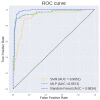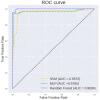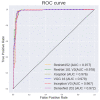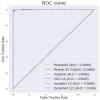Automated Detection and Classification of Oral Squamous Cell Carcinoma Using Deep Neural Networks
- PMID: 36900062
- PMCID: PMC10001077
- DOI: 10.3390/diagnostics13050918
Automated Detection and Classification of Oral Squamous Cell Carcinoma Using Deep Neural Networks
Abstract
This work aims to classify normal and carcinogenic cells in the oral cavity using two different approaches with an eye towards achieving high accuracy. The first approach extracts local binary patterns and metrics derived from a histogram from the dataset and is fed to several machine-learning models. The second approach uses a combination of neural networks as a backbone feature extractor and a random forest for classification. The results show that information can be learnt effectively from limited training images using these approaches. Some approaches use deep learning algorithms to generate a bounding box that can locate the suspected lesion. Other approaches use handcrafted textural feature extraction techniques and feed the resultant feature vectors to a classification model. The proposed method will extract the features pertaining to the images using pre-trained convolution neural networks (CNN) and train a classification model using the resulting feature vectors. By using the extracted features from a pre-trained CNN model to train a random forest, the problem of requiring a large amount of data to train deep learning models is bypassed. The study selected a dataset consisting of 1224 images, which were divided into two sets with varying resolutions.The performance of the model is calculated based on accuracy, specificity, sensitivity, and the area under curve (AUC). The proposed work is able to produce a highest test accuracy of 96.94% and an AUC of 0.976 using 696 images of 400× magnification and a highest test accuracy of 99.65% and an AUC of 0.9983 using only 528 images of 100× magnification images.
Keywords: CNN; computer vision; feature extraction; medical image analysis; oral cancer.
Conflict of interest statement
The authors declare no conflict of interests.
Figures








References
-
- Wild C.P., Weiderpass E., Stewart B.W. World Cancer Report. WHO; Geneva, Switzerland: 2020.
-
- Mouth and Oral Cancer Statistics 2020, World Cancer Research Fund International. [(accessed on 16 January 2023)]. Available online: https://www.wcrf.org/cancer-trends/mouth-and-oral-cancer-statistics/#:~:....
-
- Ilic I., Ilic M. Chewing Tobacco and Mortality of Lip and Oral Cavity Cancer. Biol. Life Sci. Forum. 2022;18:5.
-
- Sande A., Naik R.S. Oral cancer prevalence in Western population of Maharashtra, India, for a period of 5 years. J. Oral Res. Rev. 2018;10:11.
LinkOut - more resources
Full Text Sources

